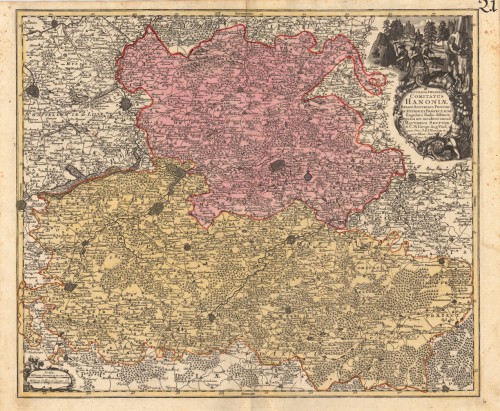Jansonnius, Joan.
Patriae antiquae Inter Iuly et Caroli Magni Caesarum Romanorum Tempora Descriptio Hewich inventur; S. Saevry Sculptor.
Eigenschaften
- Published: Janssonius Joan. , Amsterdam
- Published date: 1649
- Type: Antique Map, map
- Technique: Copper engraving / later handcolor
- Category: Low Countries
- Issue date: 1649-60
- Size: 385 by 470mm (15 by 18 inches).
- Bibliography: Koeman I / 3000H:1B;
- Stock number: 17727
- Condition: In excellent condition. 385 by 470mm (15 by 18 inches).
Article description
Article description
Original antique copper engraving, hand colored in outline and wash. The detailed map describes part of Charlemagne's Empire centered on the Rhine River, was drawn by Herman Ewich and engraved by S. Saevry. A compass rose orients this handsome map of the Netherlands and northern Germany with north to the right. Johannes Janssonius (1588, Arnhem – buried July 11, 1664, Amsterdam) (born Jan Janszoon, in English also Jan Jansson) was a Dutch cartographer and publisher who lived and worked in Amsterdam in the 17th century. Janssonius was born in Arnhem, the son of Jan Janszoon the Elder,[1] a publisher and bookseller. In 1612 he married Elisabeth de Hondt, the daughter of Jodocus Hondius. He produced his first maps in 1616 of France and Italy. In 1623 Janssonius owned a bookstore in Frankfurt am Main, later also in Danzig, Stockholm, Copenhagen, Berlin, Königsberg, Geneva and Lyon. Elisabeth Hondius died in 1627 and he remarried Elisabeth Carlier in 1629. In the 1630s he formed a partnership with his brother in law Henricus Hondius, and together they published atlases as Mercator/Hondius/Janssonius. Under the leadership of Janssonius the Hondius Atlas was steadily enlarged. Renamed Atlas Novus, it had three volumes in 1638, one fully dedicated to Italy. In 1646, a fourth volume came out with "English County Maps", a year after a similar issue by Joan Blaeu. Janssonius' maps are similar to those of Blaeu, and he is often accused of copying from his rival, but many of his maps predate those of Blaeu and/or covered different regions. By 1660, at which point the atlas bore the appropriate name "Atlas Major", there were 11 volumes, containing the work of about a hundred credited authors and engravers. It included a description of "most of the cities of the world" (Townatlas), of the waterworld (Atlas Maritimus in 33 maps), and of the Ancient World (60 maps). The eleventh volume was the Atlas of the Heavens by Andreas Cellarius. Editions were printed in Dutch, Latin, French, and a few times in German. After Janssonius's death, the publishing company was continued by his son-in law, Johannes van Waesbergen. The London bookseller Moses Pitt attempted publication of the Atlas Major in English, but ran out of resources after the fourth volume in 1683. (Wikipedia)Koeman I / 3000H:1B;
Recently viewed products






